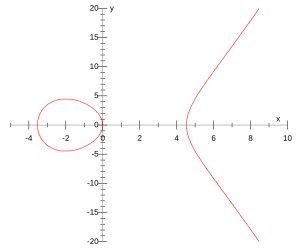
In mathematics, the doubling-oriented Doche–Icart–Kohel curve is a form in which an elliptic curve can be written. It is a special case of the Weierstrass form and it is also important in elliptic-curve cryptography because the doubling speeds up considerably (computing as composition of 2-isogeny and its dual). It was introduced by Christophe Doche, Thomas Icart, and David R. Kohel in Efficient Scalar Multiplication by Isogeny Decompositions.
Definition
Let be a field and let . Then, the doubling-oriented Doche–Icart–Kohel curve with parameter a in affine coordinates is represented by:
Equivalently, in projective coordinates:
with and .
Since this curve is a special case of the Weierstrass form, transformations to the most common form of elliptic curve (Weierstrass form) are not needed.
Group law
It is interesting to analyze the group law in elliptic curve cryptography, defining the addition and doubling formulas, because these formulas are necessary to compute multiples of points P (see Exponentiation by squaring). In general, the group law is defined in the following way: if three points lie in the same line, then they sum up to zero. So, by this property, the group laws are different for every curve shape.
In this case, since these curves are special cases of Weierstrass curves, the addition is just the standard addition on Weierstrass curves. On the other hand, to double a point, the standard doubling formula can be used, but it would not be so fast. In this case, the neutral element is θ = (0 : 1 : 0) (in projective coordinates), for which θ = −θ. Then, if P = (x, y) is a non-trivial element (P ≠ θ), then the inverse of this point (by addition) is −P = (x, −y).
Addition
In this case, affine coordinates will be used to define the addition formula:
where
and
Doubling
, where
Algorithms and examples
Addition
The fastest addition is the following one (comparing with the results given in: http://hyperelliptic.org/EFD/g1p/index.html), and the cost that it takes is 4 multiplications, 4 squaring and 10 addition.
A = Y2-Y1
AA = A
B = X2-X1
CC = B
F = X1CC
Z3 = 2CC
D = X2Z3
ZZ3 = Z3
X3 = 2(AA-F)-aZ3-D
Y3 = ((A+B)-AA-CC)(D-X3)-Y2ZZ3
Example
Let . Let P=(X1,Y1)=(2,1), Q=(X2,Y2)=(1,-1) and a=1, then
A=2
AA=4
B=1
CC=1
F=2
Z3=4
D=4
ZZ3=16
X3=-4
Y3=336
Thus, P+Q=(-4:336:4)
Doubling
The following algorithm is the fastest one (see the following link to compare: http://hyperelliptic.org/EFD/g1p/index.html), and the cost that it takes is 1 multiplication, 5 squaring and 7 additions.
A = X1
B = A-a16
C = a2A
YY = Y1
YY2 = 2YY
Z3 = 2YY2
X3 = B
V = (Y1+B)2-YY-X3
Y3 = V(X3+64C+a(YY2-C))
ZZ3 = Z3
Example
Let and a=1. Let P=(-1,2), then Q=P=(x3,y3) is given by:
A=1
B=-15
C=2
YY=4
YY2=8
Z3=16
X3=225
V=27
Y3=9693
ZZ3=256
Thus, Q=(225:9693:16).
Extended coordinates
The addition and doubling computations should be as fast as possible, so it is more convenient to use the following representation of the coordinates:
are represented by satisfying the following equations:
Then, the Doubling-oriented Doche–Icart–Kohel curve is given by the following equation:
.
In this case, is a general point with inverse . Furthermore, the points over the curve satisfy: for all nonzero.
Faster doubling formulas for these curves and mixed-addition formulas were introduced by Doche, Icart and Kohel; but nowadays, these formulas are improved by Daniel J. Bernstein and Tanja Lange (see below the link of EFD).
Internal Link
For more information about the running-time required in a specific case, see Table of costs of operations in elliptic curves
Notes
- Christophe Doche, Thomas Icart, and David R. Kohel, Efficient Scalar Multiplication by Isogeny Decompositions
References
- Christophe Doche, Thomas Icart and David R. Kohel (2006). "Efficient Scalar Multiplication by Isogeny Decompositions". Public Key Cryptography - PKC 2006. Lecture Notes in Computer Science. Vol. 3958. Springer Berlin / Heidelberg. pp. 191–206. doi:10.1007/11745853_13. ISBN 978-3-540-33851-2.
- Daniel J. Bernstein and Tanja Lange (2008). Analysis and optimization of elliptic-curve single scalar multiplication. American Mathematical Society. ISBN 9780821857892.

 be a
be a  . Then, the doubling-oriented Doche–Icart–Kohel curve with
. Then, the doubling-oriented Doche–Icart–Kohel curve with 

 and
and  .
.



 , where
, where


 . Let P=(X1,Y1)=(2,1), Q=(X2,Y2)=(1,-1) and a=1, then
. Let P=(X1,Y1)=(2,1), Q=(X2,Y2)=(1,-1) and a=1, then
 are represented by
are represented by  satisfying the following equations:
satisfying the following equations:


 .
.
 is a general point with inverse
is a general point with inverse  .
Furthermore, the points over the curve satisfy:
.
Furthermore, the points over the curve satisfy:  for all
for all  nonzero.
nonzero.